The iPhone 4 Redux: Analyzing Apple's iOS 4.0.1 Signal Fix & Antenna Issue
by Brian Klug & Anand Lal Shimpi on July 15, 2010 12:28 PM EST- Posted in
- Smartphones
- Apple
- iOS 4
- iPhone 4
- Mobile
In case you haven’t noticed, the iPhone 4’s antenna design has come under considerable scrutiny. In our iPhone 4 review, we investigated the iPhone 4 antenna and came to two conclusions. First, that iOS 4 was displaying signal bars in an overly optimistic manner, compressing the dynamic range of possible signal bars users can see. Second, we identified a worst case signal drop of around 24 dB when the iPhone 4 is cupped tightly in the left hand, covering the black strip and possibly detuning the antennas and adding additional attenuation from the presence of the hand.
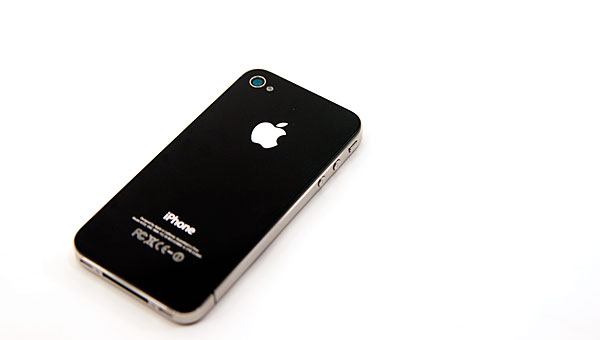
Since those initial measurements, we’ve been working tirelessly to both characterize the problem, fully understand the mechanisms behind it, and report on a number of possible solutions.
The Bars Have Changed
On July 2, Apple released a letter noting that the formula used in iOS 4.0 to calculate how many bars are presented for each signal strength is “totally wrong.” This mirrored our conclusions that the effects of the signal drop were exacerbated in part by the way the iPhone visualizes signal strength - the dynamic range is compressed so much that the 24 dB drop from cupping the phone without a case could make all the bars go away.
They went on to promise that in a future software update they would make bars 1, 2, and 3 taller, and make the bars more “accurate” by displaying 2 bars fewer in certain circumstances.
iOS 4.1 beta rolled around yesterday, and we immediately dove in to find out just how much the bar to signal strength mapping has changed. Update: iOS 4.0.1 final just came out this afternoon and we finished preliminary testing. The signal strength mapping algorithms are identical to the 4.1 beta. The findings in this article apply to 4.0.1 as well as the 4.1 beta.

After updating our devices to the iOS 4.1 beta (and 4.0.1) and making sure our little trick to show signal strength in dBm instead of bars still worked, we set off. Remember last time how I said I drove around town all day with iOS 4.0, testing the phone, and recording signal strength and how many bars were being shown? You guessed it - another update, another evening of driving around. Anand and I did quite our fair share of moving around to get a complete picture of what the new cutoffs are.
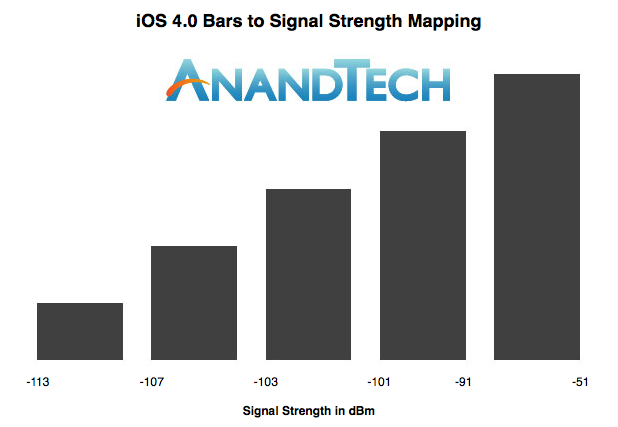
Old Bars
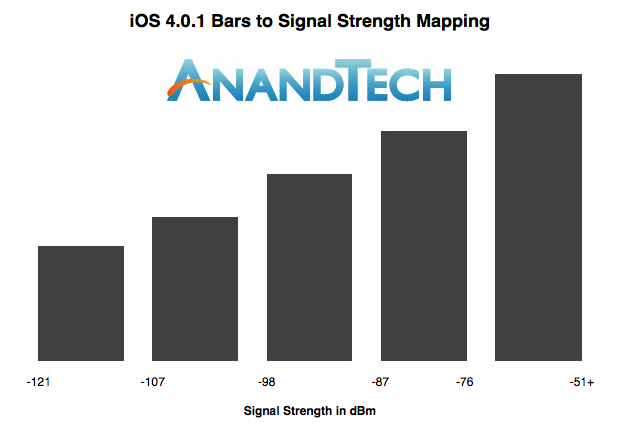
New Bars
The results are conclusive - Apple has dramatically changed the signal strength to signal bar mapping in iOS 4.0.1 and the iOS 4.1 beta, making the dynamic range not only much broader, but the range values for each bar much wider. The range of signals that correspond to bars three and four are the same width, and bar two is only slightly less.
The cutoff value for two bars to one bar remains the same, but every other value has increased. The result is that the worst case drop of 24 dBm no longer makes all the signal bars disappear, but rather two.
AnandTech reader Mike Escoffery, Director of Design and User Experience at Media Platforms, created his own diagram to help compare the old and new way of iOS signal strength reporting:
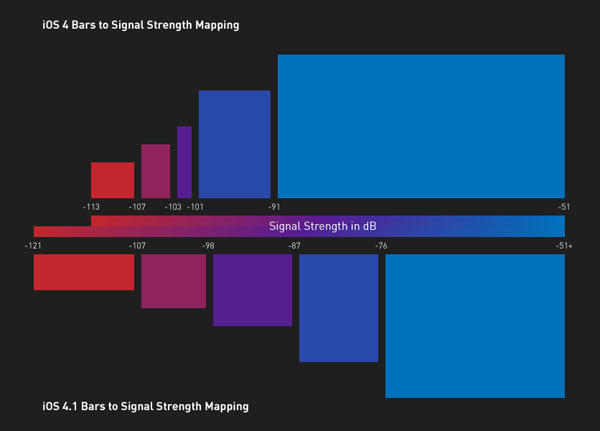
As you can see the old way (top) put far too much weight into the 5th bar of signal. Apple's new approach not only splits it up more reasonably between the 4th and 5th bar (still non-linearly keeping you in the 5th bar if possible) but also extends the range of the lower bars.
This change actually presented itself in our numeric signal strength reports - there’s more dynamic range in these numbers too. Previously, the absolute lowest value any iPhone would report was -113 dBm. With iOS 4.0.1/4.1, the value is now a shockingly low -121 dBm. In the iPhone 4 review, I talked a lot about how although the phone is prone to dropping signal from being held wrong, it was measurably more sensitive in weak signal areas. I was shocked that calls and data worked seemingly unfazed at -113 dBm. It seems as though this increased 8 dBm of range below -113 dBm was meant to show really how much more sensitive the radio stack is - it undeniably is more sensitive. Both Anand and I were able to hang onto calls all the way down at -121 dBm.
We’ve also included a comparison to how the latest version of Android displays signal bars from GSM or UMTS networks below. Thankfully, this didn’t require driving around town all day but rather inspecting the latest version of the Android source code from Google’s own repositories. Android uses an ASU value to compute signal strength, which isn’t anything more than a remapping of dBm to a sane value that’s a bit easier to interpret.
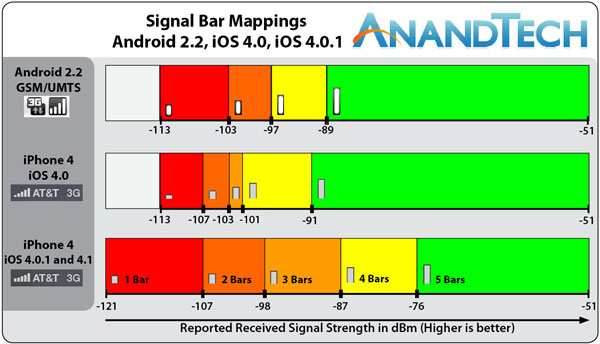
Apple’s mappings have gone from having probably the most compressed dynamic range among handset vendors to less compressed than Android.
While the software update obviously does not and cannot address the design of the antenna itself - or make the drop from holding the phone any less - it does change the way the issue is perceived among users. The result is that most iPhone users will see fewer bars disappear when they hold the iPhone 4 in a bare hand. The side effect is that the iPhone now displays fewer bars in most places, and users that haven’t been reporting signal in dBm will time see the - perhaps a bit shocking - reality of locations previously denoted as having excellent signal.
Interestingly enough, Apple has indeed changed the heights of bars 1, 2, and 3. They’re taller, and the result is that the relative heights are no longer linear, but rather a tad exponential looking. It’s a mind trick that Apple no doubt hopes will make the signal look better. If the bars are taller, they must denote stronger signal, right?
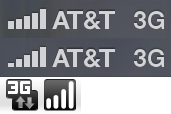
From top to bottom: iOS 4.1, iOS 4.0, Android 2.2
The reality is that Apple likely wants to deflect at least some of the initial backlash AT&T will face for reporting the signal bars without any concessions. Concessions that used to make coverage look better than it really is. Regardless of how tall the bars are, there are still going to be fewer of them virtually everywhere. Interestingly enough, while bars 1 and 2 are the most changed, their respective cutoffs are virtually unchanged.
While I was testing iOS 4.0.1, I told Anand that the signal reporting lie that started with the iPhone 3G had been removed entirely. That iOS 4.0.1 would potentially show the reality of AT&T’s coverage to iPhone users. With 4.0.1 users looking at signal bars will get a much more realistic view of how signal is changing.
We tested the iOS 4.1 beta on iPhone 3GSes as well, and found the mappings to be the same there as well.










146 Comments
View All Comments
SunSamurai - Thursday, July 15, 2010 - link
People like you are not missed. All you are is an apple basher. The phone has bugs that need to be worked out, calling broken is foolish and only shows your maturity and bias.trochevs - Thursday, July 15, 2010 - link
Mr. Anand Lal Shimpi,I love your articles, because they are very accurate, fact based, and clearly separate fact from personal options. But I feel in this particular case you are letting your personal love for Apple to ignore the facts a bit here. I have big problem with following two sections:
"We have consistently argued that the 4’s antenna is a design choice by Apple. As we’ve seen in our testing there are situations where the iPhone 4’s antenna makes things better (e.g. holding onto calls with very low signal strength) and other situations where the design makes them worse (e.g. holding it wrong in situations with low signal strength)."
"The iPhone 4 is better at holding onto calls and data at very low signal levels. We’ve mentioned this one before but it’s worth reiterating. The new antenna does let me make calls and transmit data at very low signal strength. With the iOS 4.1 update I was able to make a call at -115dB on the 3GS, however the call did drop within a minute of starting it. By comparison I was able to have a much longer conversation without dropping the call at -120dB on the 4. By no means is this a scientific comparison, but anecdotally both Brian and I feel that the low signal strength performance of the iPhone 4 is better than the 3GS."
First some facts that I have picked up while I study RF tech in order to get my M.S. in EE:
1.The signal level is measured by the receiver circuits. Usually it is the voltage that regulate the Automatic Gain Loop that is used to maintain constant signal level at the input of detector circuit.
As result any antenna gains would be clearly visible as improve signal level at all time.
2.The antenna is passive device as result it have static efficiency and antenna gain does not depends on signal strength.
I would like to point out to you inconsistency in your analysis:
1. If you can maintain better call at -120dB with iPhone4, but you can't do the same with iPhone 3Gs proves that iPhone4 have better receiver/decoder circuit then iPhone 3Gs only.
2.If the iPhone 4 antenna is better then 3Gs you are going to see better signal level on iPhone 4 in anywhere like places where the signal is strong and especially where the signal is weak. But all your test clearly shows that receiver in iPhone 4 has to work harder in order to compensate for bad antenna.
To remind you: “My mother always taught me that honesty is the best policy ...
”
So please be truthful to this statement and stop with the apologies on Apple's behalf. The only apology we need is one coming from Apple and it should be very short: “We made a mistake and we are going to fix it” that's it. Stop saying that iPhone 4's antenna is some kind of engineering compromise, because it is not. The antenna design is crap. Credits for the better operation of iPhone 4 in low signal are due to the base-band chip designer/manufacture. Please acknowledge that, they really deserve it, no Apple.
SunSamurai - Friday, July 16, 2010 - link
The ntenna design is not crap. It simply need a revision to fullfill what it was aiming for. If it were crap then they would need to fully redesign it. They do not.leexgx - Friday, July 16, 2010 - link
fast fix is just give out the bumper case and have it come with every iphoneif i was going to get an iphone (and i am not) the first thing i would buy is the case or full case(protect the back and front) as it not that hard to shatter the screen or the back now
most of my house all runs on Android based phones here from when posting(apart form my main phone thats HTC HD1 WIN 6.1 for business use but i am considering going all Android as text input is faster under my desire phone)
T-mobile G1 thats been passed down (main issue bat is crap had to fit an 2000mha bat to make the phone usefull) ,
upgrade to T-mobile HTC desire as my second phone HD1 main (bigger bat as default seems to last day and an half now),
Orange - Sony X10 {big one} works well big screen and big cam on it (only bad thing is seems to be an finger smugs magnet on the screen)
Orange Samsung Galaxy S (that looks more like an iphone with the middle button)
iwod - Thursday, July 15, 2010 - link
I dont think anand is Pro Apple, it sounds more like you are Anti Apple.The Antenna is not broken. It may have faults and its problem. But it still does calls and data in most if not all situation. Well thanks to US which has poor coverage and signal from AT&T. You will be worse then others around the world.
If i put how Motorola's design and tune their Antenna as Standard. Then pretty much 95% of all phone sold by Non Motos have problems. Or according to your wording, Broken.
It doesn't come with a broken USB Port.
Bluetooth is an Software problem.
If you can not stand software problems, then dont even go on to internet. Because every single devices on earth have it. And you should complain about Windows Mobile first.
slickr - Friday, July 16, 2010 - link
O please spare me the lecture.I have not expressed in any way that I'm anti Apple now have I, but when I see a bad device and Anandtech staff trying to defend Apple and say that users are wrong for "holding it wrong", its just the bars and not the antenna that is wrong, makes me sick.
I have huge respect for this website, but right now some of that respect is shattered.
You sir, can not comprehend the facts! If the antenna can't catch signal if you are holding it in a particular way that is considered broken. That's like Razor mouse not registering movements if you put your hand on it in a particular way. Yes it may work 80% of the time, but that does not change the fact it wont work 20% of the time.
There are several reports of broken or in other words faulty USB port. In some instances on some iPhone 4 the USB makes an electrical surge when connected with a USB cable and it gets destroyed. This is firstly not safe for the health of the users and screws your iPhone 4, so you need to get it to service to repair the broken USB port.
How do you know bluetooth problems are software? This is the Apple favoritism. It may or may not be software problem, but the fact is there is a problem with it.
If you go buy Apple I don't care, its your personal opinion, but having a huge and well known website advertise Apple in these articles if beyond all credibility !!!
SunSamurai - Friday, July 16, 2010 - link
Its not considered broken, because it still works. Try the dictionary before telling people to comprehend words ;)slickr - Saturday, July 17, 2010 - link
It only works part time, so its broken.Take this for example: Your brand new $500 dollars TV all of a sudden stops working, than after placing it in a different position starts working again, than the problem occurs again and you move it again. No matter what you do it still keeps reoccurring and the only way to fix it is by buying additional stuff for it.
I consider that broken and would never want to buy a TV from that manufacturer again, but it the case of Apple's iPhone 4 its being defended and promoted as user problem for "holding it wrong" Come on.
And that is only one of the multiple problems Apple has with the iPhone!
anandreader - Sunday, July 18, 2010 - link
It's broken for some people, not for others. I don't experience the problem because I avoid touching the antenna at the gap. I'm also right handed so that's easy for me. For a left-handed person, yeah it's going to be broken if they can't hold it the way they'd like to hold it.For me, the phone is better than any other cell phone I've had. When I'm in a strong signal area, the phone sounds like a landline phone - the voice on the other end is crisp and static free.
Bottom line - the antenna is only an issue for some, not all, people. Your statement that the antenna is broken is overly broad.
slickr - Tuesday, July 20, 2010 - link
You just proved my point, even if only 10 out of 10 million people are affected its broken. And it could also happen to you and any other in any case, just touch is in the spot and the antenna loose connection and whoala a problem.Plus iPhone 4 is crap in other areas too, I'd gladly take the Samsung or Nokia N900 any day over the iPhone!